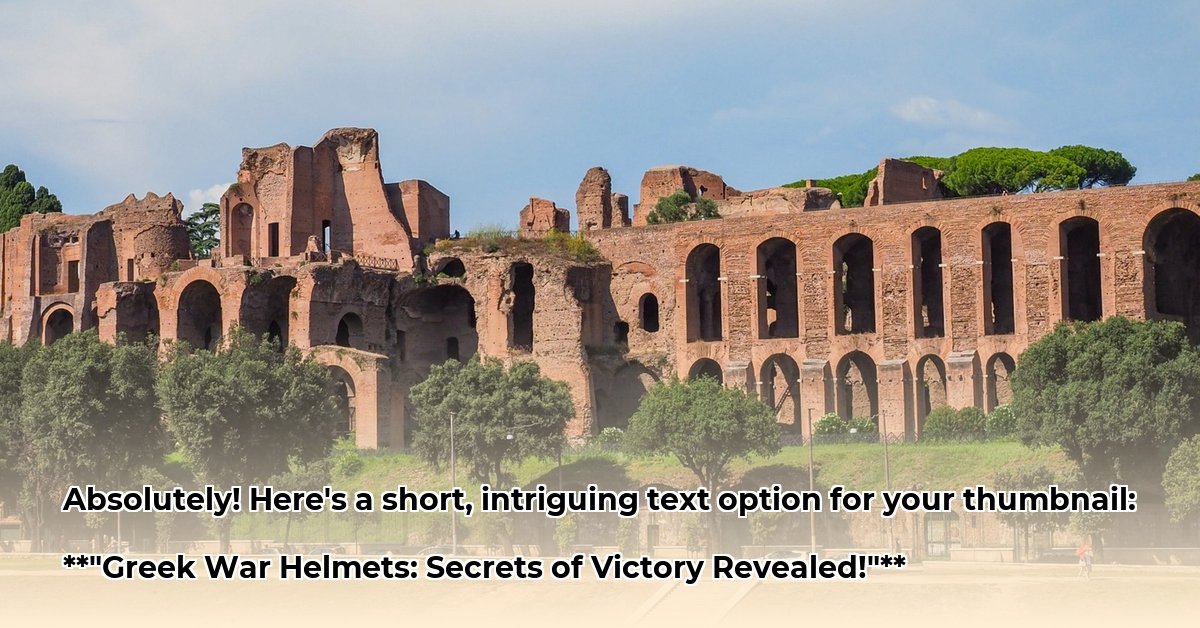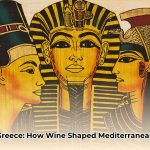Imagine the cacophony of an ancient Greek battlefield: the clash of bronze, the shouts of hoplites, the swift, deadly precision of a spear thrust. In this brutal theater of war, personal armor was not merely equipment; it was a testament to a warrior’s resolve, his status, and often, his very survival. Among the myriad pieces of Greek panoply, the helmet stands out as an iconic symbol. From rudimentary Bronze Age designs to highly specialized forms, ancient Greek helmets underwent a profound evolution over centuries, continually adapting to shifting military tactics, technological advancements, and the changing demands of the battlefield. This journey through time reveals a fascinating interplay between defensive innovation, economic realities, and the very human need to protect one’s head in the crucible of combat. Further insights can be found about Greek armor.
Unveiling Ancient Greek Helmets: A Chronological and Tactical Overview
The story of ancient Greek helmets is a chronicle of continuous adaptation, reflecting advancements in metallurgical skill and strategic thought. Their progression from simplistic head coverings to intricate, purpose-built designs highlights humanity’s persistent drive for superior protection.
The Dawn of Protection: Early Forms and Materials
The earliest forms of head protection in the Aegean world predate the Classical age, reaching back into the Bronze Age. Long before the widespread use of bronze for full helmets, inventive solutions emerged.
- The Boar’s Tusk Helmet: One of the most unique and ancient forms of headgear, dating from the Mycenaean period (around the 16th century BC), was the boar’s tusk helmet. Far from a simple cap, these helmets were meticulously crafted from hundreds of slivers of boar tusks, carefully shaped, drilled, and stitched onto a strong leather or felt base. Homer’s Iliad vividly describes such a helmet, worn by Odysseus, underscoring its historical significance and status as an heirloom. While not as robust as later metal helmets, it provided formidable protection against glancing blows and was a clear indicator of the wearer’s prominence.
Early Bronze Forgings: The Kegelhelm
As the Iron Age dawned in Greece, bronze began to dominate helmet construction. The Kegelhelm (meaning “cone helmet” in German), emerging around the 10th-8th centuries BC, represents one of the earliest standardized bronze helmet types. Often constructed from several bronze segments riveted together, it formed a conical cap, sometimes with modest cheek extensions. While an advancement from earlier forms, its sectional construction made it vulnerable at the seams. Archaeological finds, particularly from Argos, highlight its early prevalence. The Kegelhelm’s limitations ultimately spurred the development of more robust, one-piece designs.
The Archaic & Classical Eras: Balancing Protection and Awareness
The 7th and 6th centuries BC saw significant innovations, with new helmet types emerging that grappled with the fundamental trade-off between comprehensive protection and essential battlefield awareness (vision, hearing, and communication).
-
The Illyrian Helmet: Developing from the Kegelhelm around the 7th century BC in the Peloponnese, the Illyrian helmet featured a distinctive quadrangular face opening, prominent fixed cheekpieces, and parallel raised lines along the crown for attaching a crest. Despite its name, derived from early archaeological finds in Illyria, its origins were firmly Greek. While offering better visibility than later enclosed designs, early Illyrian helmets somewhat hampered hearing. Subsequent iterations (Types I-IV) gradually improved hearing while maintaining neck protection, making it a popular trade item across the Mediterranean until the 5th century BC.
-
The Corinthian Helmet: Iconic Protection at a Cost: Arguably the most iconic ancient Greek helmet, the Corinthian (also developed in the Peloponnese in the 7th century BC) rapidly became synonymous with the Greek hoplite. Characterized by its almond-shaped eyeholes, prominent nose guard, and large, unhinged cheek pieces that covered the entire face, it offered unparalleled protection against direct frontal blows. Its menacing, theatrical appearance made it a favored motif in Greek art, often romanticized as a symbol of glory. However, the comprehensive coverage came at a significant price: severely restricted peripheral vision, muffled hearing, and hampered communication. In non-combat situations, hoplites often pushed the helmet back onto their heads for comfort and awareness. This practical limitation contributed to its decline by the end of the 5th century BC in favor of more open, versatile designs.
-
The Chalcidian Helmet: Finding the Middle Ground: Emerging in the latter half of the 6th century BC, the Chalcidian helmet represented a pragmatic evolution from the Corinthian. It sought to provide decent protection without completely sacrificing the wearer’s senses. Visually similar to the Corinthian but with less pronounced cheekpieces (often hinged for anatomical fit) and an ear opening, it offered a wider field of view. The nasal bar could be less prominent or even absent in later variants. Its widespread geographical distribution, from Spain to the Black Sea, attests to its versatility and popularity as Greek armies began incorporating more cavalry and light infantry, demanding greater battlefield perception.
Specialized Designs & Later Adaptations: The Hellenistic Period
As warfare continued to evolve, particularly with the rise of specialized units like cavalry and skirmishers, helmet designs became more tailored to specific roles and less universally encompassing.
-
The Phrygian (Thracian) Helmet: Forward-Leaning Distinction: Developed from the Chalcidian helmet in the late 6th century BC, the Phrygian (also known as the Thracian) helmet is instantly recognizable by its distinctive forward-leaning apex, which mimicked the felt shepherd’s caps of Anatolia. Often made with a flanged lower border forming a visor, it featured separately made, hinged cheek pieces, sometimes elaborately decorated to mimic facial hair. Though its name points to Phrygia, these helmets were predominantly found in Thrace (modern Greece, Turkey, Bulgaria). It gained immense popularity during the Hellenistic period, particularly with the Macedonian cavalry of King Philip II and later Alexander the Great’s infantry, as seen on the Alexander Sarcophagus.
-
The Attic Helmet: Style and Enduring Symbolism: Emerging in the latter half of the 5th century BC, the Attic helmet is characterized by its close-fitting dome, an elongated visor, and anatomically formed, often hinged, cheek pieces. Unlike many earlier types, it was frequently made of iron, though fewer examples survive due to corrosion. While originating in mainland Greece, its use became particularly widespread in Italy and the Roman world. The Attic helmet, often ornately decorated with pediments and crest attachments, became a popular artistic motif in Roman reliefs, symbolizing martial prowess and harking back to Greek heritage, even if its practical battlefield use by Roman legionaries was limited, perhaps reserved more for ceremonial display.
-
The Boeotian Helmet: The Cavalryman’s Choice: The Boeotian helmet, emerging in the 4th century BC, stands out as the only ancient Greek helmet still known by its original name, thanks to the military historian Xenophon. He specifically recommended this open, broad-brimmed helmet for cavalry, praising its “free vision” and protection of “all the parts above the cuirass.” Modeled on the petasos, a Greek sun hat, its design provided an unparalleled field of view and unimpaired hearing, crucial for mounted combat. Alexander the Great reportedly equipped his elite Companion cavalry with this type, solidifying its reputation as the ultimate cavalry helmet.
-
The Pilos Helmet: Simplicity, Adaptability, and Mass Appeal: The Pilos helmet, which gained popularity from the 4th to 3rd centuries BC, was the simplest of the ancient Greek helmets. Consisting of little more than a conical, upright bronze form, it mirrored the basic felt pileus cap. Its popularity surged with the changing nature of Hellenistic warfare, where soldiers needed greater situational awareness. Being simple, lightweight, and inexpensive to produce, it was favored by regular infantry, including the Spartans, offering basic protection while maximizing vision and hearing. Its adaptability led to variations with hinged cheek pieces and crest attachments.
-
The Konos Helmet: A Late Hellenistic Development: As an evolution of the Pilos, the Konos helmet emerged in the late Classical and Hellenistic periods. Also conical, it typically featured a thin brim protruding from its base and often included bronze ear guards extending to the jawbone. Described in the Military Decree of Amphipolis, the Konos was specified as the helmet for phalangites, Alexander’s heavy infantry. It represented a functional, streamlined design, blending the Pilos’ simplicity with added features for enhanced protection.
The table below summarizes the key characteristics and tactical roles of prominent ancient Greek helmet types, illustrating their evolution from limited protection to highly specialized forms:
| Helmet Type | Primary Period | Protection Level | Situational Awareness | Common Users | Key Distinguishing Features | Tactical Role |
|---|---|---|---|---|---|---|
| Boar’s Tusk | Mycenaean Bronze Age | Medium | High | Elite Warriors | Tusks stitched onto leather/felt base, unique material | Early status symbol, protection from glancing blows |
| Kegelhelm | Iron Age (10-8th CBC) | Basic | High | Early Warriors | Conical, riveted bronze segments, early form | Fundamental head defense |
| Illyrian | Archaic/Classical (7-5th CBC) | Medium | Medium-High | Various Greek soldiers | Quadrangular face opening, fixed cheekpieces, parallel ridges for crest | Versatile infantry, trade good |
| Corinthian | Archaic/Early Classical (7-5th CBC) | High | Low | Hoplites | Full facial coverage, almond eyes, prominent nose guard | Frontline heavy infantry in dense phalanx |
| Chalcidian | Classical (6-4th CBC) | Medium | Medium-High | Various Greek soldiers | Ear openings, often hinged cheekpieces, less restrictive than Corinthian | Adapts to varied infantry roles, better visibility |
| Phrygian (Thracian) | Classical/Hellenistic (late 6th CBC onwards) | Medium | Medium | Macedonian Infantry/Cavalry | Distinctive forward-leaning apex, hinged cheekpieces, often decorated | Favored for mobility and visibility in formations |
| Attic | Classical/Hellenistic (late 5th CBC onwards) | Medium | Medium | Officers, Roman soldiers | Often iron, integrated cheekpieces, prominent brow band | Leadership, ceremonial; functional in cavalry/light infantry |
| Boeotian | Classical/Hellenistic (4th CBC onwards) | Medium | High | Cavalry | Wide, flaring brim, open face, excellent vision, based on petasos | Optimized for mounted combat, high awareness |
| Pilos | Classical/Hellenistic (mid 6th CBC onwards) | Low-Medium | High | Spartans, Light Infantry | Simple conical shape, economical, often no added features | Affordable, light, promotes communication in phalanx |
| Konos | Hellenistic (late 4th CBC onwards) | Medium | High | Phalangites | Pointed conical shape, brim, often with ear guards | Standard for Hellenistic pike infantry |
Tactical Implications: Reshaping Battlefield Strategy
The evolution of ancient Greek helmets had profound tactical implications, directly influencing battlefield formations, communication, and individual soldier effectiveness. The shift from enclosed to more open designs represented a fundamental strategic reassessment.
-
Maximum Protection, Limited Sensory Input: The Corinthian helmet, while a formidable shield, severely hindered a hoplite’s ability to see, hear, and communicate. This necessity reinforced the importance of the phalanx’s rigid discipline and cohesion. Soldiers relied on their comrades and the collective strength of the formation, trusting that their flanks and rear were protected by the impenetrable wall of shields and coordinated movements. Individual initiative was secondary to collective action.
-
Enhanced Awareness, Increased Adaptability: Conversely, the open designs of the Chalcidian, Pilos, Boeotian, and Konos helmets heralded a new era of battlefield dynamics. These helmets allowed for significantly improved peripheral vision and auditory input, vital for reacting quickly to dynamic threats, personal duels, and complex maneuvers. This enhanced awareness enabled better individual decision-making, fostered quicker responses to commands, and facilitated more fluid tactical adjustments during combat. For cavalry (Boeotian) or light infantry (Pilos), this increased awareness was paramount for speed, maneuverability, and coordinated action.
-
Specialization for Role: The deliberate design choices, such as the Boeotian helmet optimized for cavalry, underscore a growing military sophistication. Specialized equipment for different military units amplified their effectiveness in their unique roles, allowing for distinct tactical doctrines to emerge and be perfected. This trend reflected a move away from a monolithic hoplite force towards a more diversified army capable of responding to a wider range of battlefield challenges.
| Helmet Type | Key Advantages | Key Disadvantages | Primary Tactical Impact |
|---|---|---|---|
| Boar’s Tusk | Lightweight, status symbol, protection for leaders | Limited against direct heavy blows | Ideal for heroic single combat; indicated high social standing, potentially boosting morale. |
| Kegelhelm | Basic head protection, relatively light | Weak points at seams, limited facial coverage | Enabled early organized warfare by providing fundamental defense, but its structural flaws underscored the need for improved metallurgical techniques and designs. |
| Illyrian | Good head/neck protection, decent visibility | Early versions impaired hearing, face still exposed | Supported the development of more open formations and individual dueling, allowing for better situational awareness than fully enclosed designs while maintaining a strong defense. |
| Corinthian | Maximum frontal protection, intimidating appearance | Severely limited vision, hearing, and communication | Enforced strict phalanx discipline; hoplites primarily focused on frontal engagements, trusting comrades to cover flanks. Symbolized collective strength and unyielding defense. |
| Chalcidian | Balanced protection and sensory awareness | Less comprehensive than Corinthian in facial coverage | Facilitated more dynamic infantry tactics; allowed soldiers to react faster and coordinate better in evolving battlefield situations, supporting a broader range of combat roles beyond the rigid phalanx. |
| Phrygian (Thracian) | Distinctive, good for downward blows, hinged cheeks | Forward apex could catch on overhead obstacles | Popular with Macedonian armies, promoting unit cohesion and recognition. Its design allowed for better head mobility and awareness crucial for cavalry maneuvers and highly effective pike formations. |
| Attic | Aesthetic appeal, adaptable, moderate protection | Often more symbolic than purely functional in Roman context | Signified elite status and heritage, potentially boosting morale and command presence. Its practical design made it suitable for various light infantry and cavalry roles, particularly outside mainland Greece. |
| Boeotian | Excellent vision and ventilation for cavalry | Less direct facial protection, distinctive silhouette | Revolutionized cavalry combat by prioritizing extreme situational awareness, allowing for rapid maneuvers, flanking actions, and precise coordination. Directly influenced Alexander the Great’s cavalry tactics. |
| Pilos | Lightweight, inexpensive, excellent awareness | Minimal facial and neck protection | Enabled the equipping of larger armies economically. Its open design fostered better communication within the phalanx, enabling quicker commands and responses, and made it suitable for diverse roles including skirmishers and archers. |
| Konos | Streamlined, good for pike formations | Basic protection, less ornate | Standardized head protection for phalangites, ensuring uniformity and basic defense for the massed pike formations of the Hellenistic armies, supporting their overwhelming offensive power. |
Beyond the Battlefield: Social, Economic, and Cultural Significance
Ancient Greek helmets were far more than mere protective gear; they were deeply interwoven with the social fabric, economic realities, and cultural identity of the polis (city-state).
-
Status and Wealth: The production of a bronze helmet required considerable metallurgical skill and a significant investment in raw materials. Consequently, owning a well-crafted helmet, especially one with intricate decorations or a distinct style, was a clear indicator of wealth and high social standing. Helmets served as tangible symbols of a citizen’s ability to afford their panoply, reinforcing their place within the hoplite class—the elite stratum of citizen-soldiers. Ornate crests, often made of horsehair or feathers, further accentuated this stratification, projecting an image of power and prestige on the battlefield.
-
Cultural Identity and Art: The iconic designs, particularly the Corinthian, often appeared in sculptural reliefs, pottery, and funerary art. They symbolized heroism, military prowess, and the idealized image of the Greek warrior. This artistic representation extended beyond practicality, making helmets enduring cultural emblems that connected contemporary society to a romanticized past. For example, the persistence of the Corinthian helmet in art long after its battlefield obsolescence underscores its powerful symbolic resonance.
-
Craftsmanship and Technological Mastery: The evolution of helmet forms also showcases the remarkable craftsmanship and technological ingenuity of ancient Greek artisans. From the multi-piece Kegelhelm
- Unearth ancient rome achievements: Engineering feats & legal legacies, examined - August 13, 2025
- Unlock ancient rome army ranks: Power, impact & legion command - August 13, 2025
- Conquer Your Exam: Ancient Greece Quiz Ace It Now! - August 13, 2025
















